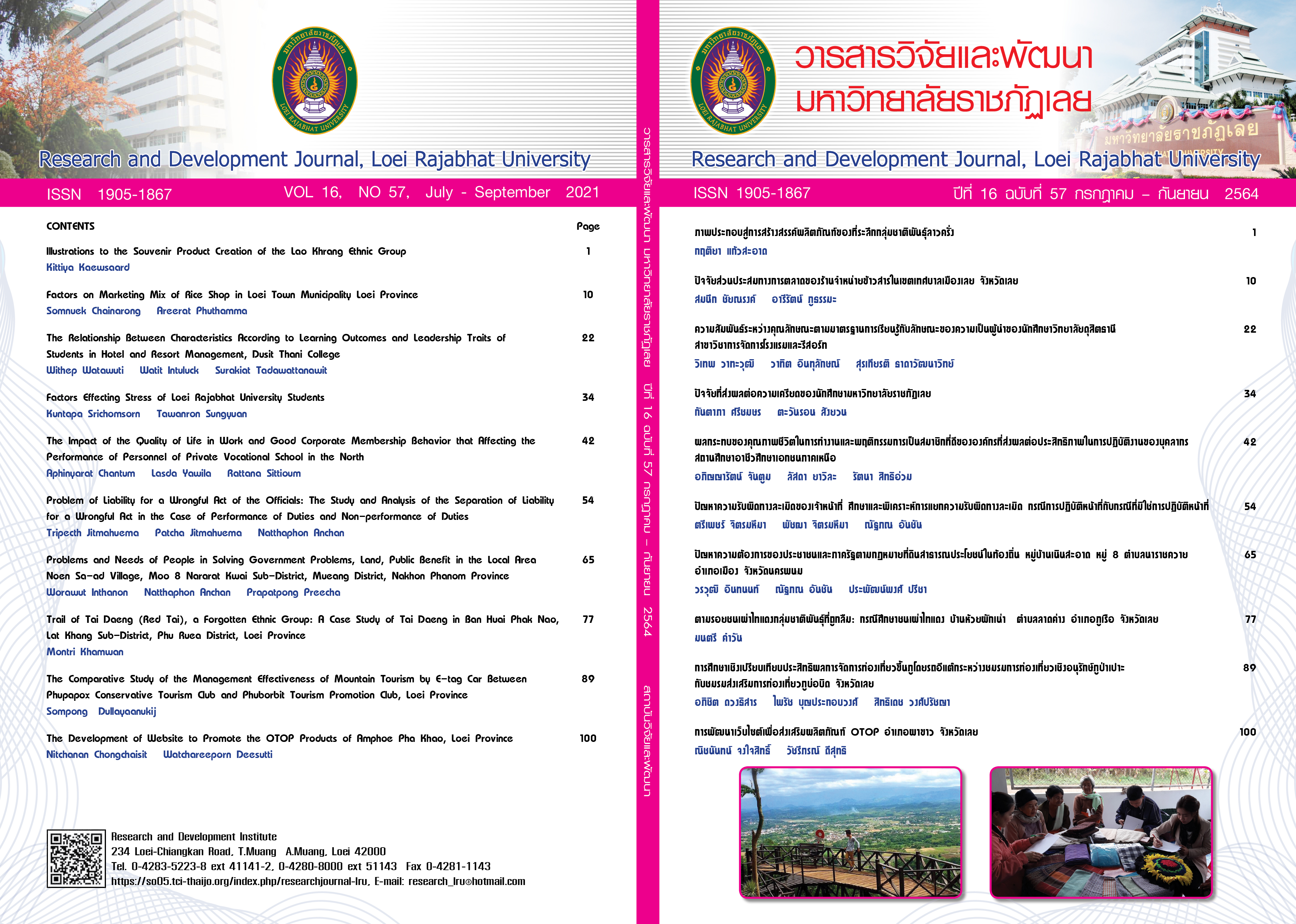Trail of Tai Daeng (Red Tai), a Forgotten Ethnic Group: A Case Study of Tai Daeng in Ban Huai Phak Nao, Lat Khang Sub-District, Phu Ruea District, Loei Province
Keywords:
Tai Daeng ethnicity, custom, tradition, ritual, wisdomAbstract
This study aimed to: 1) examine the background of Tai Daeng ethnicity; 2) examine the livelihoods of those in the Tai Daeng ethnicity; and 3) examine the adaptation of Tai Daeng ethnicity to social changes from past to present. This is a qualitative study in the study area of Ban Huai Phak Nao, Lat Khang Sub-district, Phu Ruea District, Loei Province. The samples in the study were 20 village leaders, folk sages, residents, and juveniles selected by purposive sampling. The instrument was an interview form for a focus group.
The findings revealed that the Tai Daeng ethnicity in Ban Huai Phak Nao, Lat Khang Sub-district, Phu Ruea District, Loei Province, emigrated from Qi City in Sib Song Ju Tai, Vietnam, to Xiengkho District in Hua Pan, Lao PDR. Eventually, they immigrated and settled in Thailand in Ban Huai Phak Nao, Lat Khang Sub-district, Phu Ruea District, Loei Province around 1874 because it was an unflooded upland with forests and mountains similar to their native home. For the livelihoods of the Tai Daeng ethnicity, they mostly make a living from agriculture, with extra work as lottery sellers. They have their own unique ethnic culture, e.g. spoken language, written language, costumes, traditions, customs, and rituals. Their daily livelihood still attaches to traditions and changes in several aspects following globalization trends. Technologies or facilities have been brought and applied in their daily lives. Mobile phones are currently used for faster communication and more convenience. Some customs, cultures, and traditions have become more flexible so that their livelihoods will conform to the changing times. The past language was the Tai Daeng language, influenced by the culture of North Vietnam and partly by South China. However, the inhabitants of Ban Huai Phak Nao currently use the Tai Loei language with a Dan Sai accent. Up until now, the Tai Deng people have conserved and inherited the uniqueness as well as the remarkable folk wisdom, traditions, and cultures of their community.
References
เกียรติศักดิ์ บังเพลิง. (2558). ชุมชนชาติพันธุ์ “บรู” ร่วมสมัยบนพื้นที่ชายแดนไทย-ลาว: วิถีชีวิตและการปรับตัวทางวัฒนธรรม (วิทยานิพนธ์ดุษฎีบัณฑิต). มหาวิทยาลัยธรรมศาสตร์, กรุงเทพฯ.
จตุพล ทองสกล. (2553). การดำรงอัตลักษณ์ทางชาติพันธุ์ของชาวไทดำ บ้านหัวถนน ตำบลดอนพุทรา อำเภอดอนตูม จังหวัดนครปฐม (วิทยานิพนธ์ศิลปศาสตรมหาบัณฑิต). มหาวิทยาลัยศิลปากร, กรุงเทพฯ.
จิราวรรณ ชัยยะ. (2540). การเปลี่ยนแปลงและปรับตัวทางสังคมของชาวเขาเผ่าอีก้อ(อาข่า) บ้านผาหมี อำเภอแม่สาย จังหวัดเชียงราย (วิทยานิพนธ์ศิลปศาสตรมหาบัณฑิต). มหาวิทยาลัยนเรศวร, พิษณุโลก.
เทวรักษ์ สาระมโน. (2562). รายงานการวิจัยเรื่อง ไทแดงกับการเปลี่ยนแปลงการใช้ชีวิต: กรณีศึกษาไทแดงอำเภอภูเรือ จังหวัดเลย (รายงานการวิจัย). เลย: มหาวิทยาลัยราชภัฏเลย.
สำนักงานจังหวัดเลย. (2562, 16 มกราคม). ประวัติศาสตร์จังหวัดเลย. สืบค้นจาก http://www.loei.go.th/LW/index.php/en/2017-06-02-06-34-46/2017-06-02-06-15-
Downloads
Published
How to Cite
Issue
Section
License
ข้อความที่ปรากฎในวารสารฉบับนี้เป็นความคิดเห็นของผู้เขียนแต่ละท่าน สถาบันวิจัยและพัฒนา มหาวิทยาลัยราชภัฏเลย และกองบรรณาธิการ ไม่จำเป็นต้องเห็นด้วยและไม่มีส่วนรับผิดชอบใดๆ
สถาบันวิจัยและพัฒนา มหาวิทยาลัยราชภัฏเลย ขอให้ผู้อ่านอ้างอิงในกรณีที่ท่านคัดลอกเนื้อหาบทความในวารสารฉบับนี้






